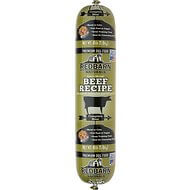
DogFoodAdvisor is reader supported See how
All reviews are 100% impartial but if you buy using links on this page, we may earn a referral fee.
Our Verdict
Redbarn Semi-Moist Rolled Dog Food product range is made up of five recipes with ratings varying from 2.5 to 3 stars. The average rating of the whole range is 3 stars.
Pros
- Cooked at a low temperature to preserve nutrients and minerals
- Granted SQF Food Safety Code for Manufacturing certification
- Convenient alternative to raw food
Cons
- Expensive
- Includes controversial and unwanted ingredients
The table below shows each recipe in this range including our rating and the AAFCO nutrient profile: Growth (puppy), Maintenance (adult), All Life Stages, Supplemental or Unspecified.
| Product line | Rating | AAFCO |
|---|---|---|
| Redbarn Semi-Moist Rolled Dog Food Original Beef Recipe | 2.5 | M |
| Redbarn Semi-Moist Rolled Dog Food Original Chicken Recipe | 2.5 | A |
| Redbarn Semi-Moist Rolled Dog Food Original Lamb Recipe | 3 | A |
| Redbarn Semi-Moist Rolled Dog Food Grain-Free Beef Recipe | 2.5 | M |
| Redbarn Semi-Moist Rolled Dog Food Grain-Free Chicken Recipe | 2.5 | A |
Recipe and Label Analysis
Redbarn Semi-Moist Rolled Dog Food Original Beef Recipe was selected to represent the other products in the line for detailed recipe and nutrient analysis.
Red Barn Naturals Beef Recipe
Estimated Dry Matter Nutrient Content
Protein
Fat
CarbsCarbohydrates
Beef, beef liver, beef lung, whole wheat flour, sucrose, pea protein, dicalcium phosphate, brown rice flour, egg product, sea salt, beef fat (preserved with mixed tocopherols), flaxseed, potassium chloride, natural smoke flavor, calcium carbonate, sodium tripolyphosphate, sodium erythorbate, rosemary, choline chloride, iron oxide, zinc sulfate, vitamin E supplement, copper sulfate, niacin supplement, calcium pantothenate, manganous oxide, vitamin A acetate, sodium selenite, riboflavin supplement, ethylenediamine dihydroiodide, vitamin B12 supplement, thiamine mononitrate, pyridoxine hydrochloride, ferrous sulfate, vitamin D3 supplement, folic acid
Fiber (estimated dry matter content) = 3%
Red denotes any controversial items
| Estimated Nutrient Content | |||
|---|---|---|---|
| Method | Protein | Fat | Carbs |
| Guaranteed Analysis | 14% | 6% | NA |
| Dry Matter Basis | 25% | 11% | 57% |
| Calorie Weighted Basis | 23% | 24% | 53% |
Ingredients Analysis
The first ingredient in this dog food is beef. Beef is defined as “the clean flesh derived from slaughtered cattle” and includes skeletal muscle or the muscle tissues of the tongue, diaphragm, heart or esophagus.1
Beef is naturally rich in all 10 essential amino acids required by a dog to sustain life.
The second ingredient is beef liver. This is an organ meat sourced from a named animal and thus considered a beneficial component.
The third ingredient is beef lung, a protein-rich organ meat that’s also low in fat.
The fourth ingredient is sucrose, a common sweetener better known as table sugar. Sugar is always an unwelcome addition to any dog food. Because of its high glycemic index, it can unfavorably impact the blood glucose level of most animals soon after it’s eaten.
The next ingredient is wheat flour, a highly-refined product of wheat milling. Like corn, wheat is an inexpensive and controversial cereal grain of only modest nutritional value to a dog.
For this reason, we do not consider wheat a preferred component in any dog food.
The sixth ingredient is pea protein, what remains of a pea after removing the starchy part of the vegetable.
Even though it contains over 80% protein, this ingredient would be expected to have a lower biological value than meat.
And less costly plant-based products like this can notably boost the total protein reported on the label – a factor that must be considered when judging the meat content of this dog food.
The seventh ingredient is brown rice, a complex carbohydrate that (once cooked) can be fairly easy to digest. However, aside from its natural energy content, rice is of only modest nutritional value to a dog.
The eighth ingredient is dried egg product, a dehydrated form of shell-free eggs. Quality can vary significantly. Lower grade egg product can even come from commercial hatcheries – from eggs that have failed to hatch.
In any case, eggs are easy to digest and have an exceptionally high biological value.
The ninth ingredient is dicalcium phosphate, likely used here as a dietary calcium supplement.
From here, the list goes on to include a number of other items.
But to be realistic, ingredients located this far down the list (other than nutritional supplements) are not likely to affect the overall rating of this Redbarn product.
With five notable exceptions…
First, flaxseed is one of the best plant sources of healthy omega-3 fatty acids. Provided they’ve first been ground into a meal, flax seeds are also rich in soluble fiber.
However, flaxseed contains about 19% protein, a factor that must be considered when judging the actual meat content of this dog food.
Next we find sodium erythorbate which is not an AAFCO defined ingredient. As it is not an AAFCO defined ingredient, it should not be included within pet food. We are disappointed to see sodium erythorbate included in foods. It is primarily used as an antioxidant, a preservative and a curing accelerator in meat and fish.
In addition, this food includes iron oxide, which is a synthetic color additive used in industry to impart a reddish color to food – and paint. In its natural form, this chemical compound is more commonly known as “iron rust”.
Next, this recipe contains sodium selenite, a controversial form of the mineral selenium. Sodium selenite appears to be nutritionally inferior to the more natural source of selenium found in selenium yeast.
And lastly, the minerals listed here do not appear to be chelated. And that can make them more difficult to absorb. Chelated minerals are usually associated with higher quality dog foods.
Nutrient Analysis
Based on its ingredients alone, Redbarn Naturals Dog Food Rolls looks like an average rolled product.
The dashboard displays a dry matter protein reading of 25.4%, a fat level of 11.5% and estimated carbohydrates of about 55.7%.
As a group, the brand features an average protein content of 25.7% and a mean fat level of 11.8%. Together, these figures suggest a carbohydrate content of 55.4% for the overall product line.
And a fat-to-protein ratio of about 46%.
Which means this Redbarn product line contains…
Below-average protein. Below-average fat. And above-average carbs when compared to a typical rolled dog food.
When you consider the protein-boosting effect of the pea protein and flaxseed, this looks like the profile of a rolled product containing a moderate amount of meat.
Redbarn Dog Food Recall History
The following automated list (if present) includes all dog food recalls related to Redbarn through December 2025.
You can view a complete list of all dog food recalls since 2009 here.
Our Rating of Redbarn Semi-Moist Rolled Dog Food
Redbarn Naturals Rolls lists both grain-inclusive and grain-free semi-moist dog foods using a moderate amount of named meats as their dominant source of animal protein, thus earning the brand 2 stars.
Compare Redbarn Semi-Moist Rolled Dog Food
How does Redbarn Semi-Moist Rolled compare with The Dog Food Advisor's most recommended brands?
A Final Word
The Dog Food Advisor does not accept money, gifts, samples or other incentives in exchange for special consideration in preparing our reviews.
However, we do receive a referral fee from online retailers (like Chewy or Amazon) and from sellers of perishable pet food when readers click over to their websites from ours. This helps cover the cost of operation of our free blog. Thanks for your support.
For more information, please visit our Disclaimer and Disclosure page.








